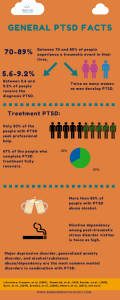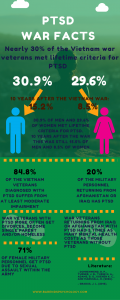What is PTSD?

Exposure to trauma can lead to long-term consequences [1] including the development of post-traumatic stress disorder (PTSD). Trauma is a perceived experience that threatens injury, death, or physical integrity and causes feelings of helplessness, fear and terror [2]. Examples of traumatic events are car accidents, sexual and physical assault, being bullied, and a natural disaster, and can occur during a single event (acute) or as a result of repeated (chronic) exposure [2]. Everybody can experience a traumatic event at one point in their lives: trauma does not discriminate against gender, age, sexual orientation, race or ethnicity. In the United States, it is estimated that approximately 6-7% of the population will experience a traumatic event at some point in their lifetime [3].
On this page the difference between post-traumatic stress disorder (PTSD), complex PTSD, and post-traumatic stress is being discussed. In short, the differences between them are:
- Post-traumatic stress disorder (PTSD) is a mental disorder that seriously affects the lives of individuals. There are four symptom clusters: avoidance, numbing, hyper-arousal, and re-experiencing/intrusive symptoms.
- Complex PTSD is a developmental trauma disorder that can develop after repeated, chronic or prolonged exposure to traumas, such as childhood sexual abuse or domestic violence. These types of traumas often trigger more complex reactions, including emotional self-regulation difficulties, negative self-concept, and relationship difficulties [4].
- Post-traumatic stress (also referred to Acute Stress Disorder) is a condition people may experience after being exposed to a traumatic event. Up until 30 days after the traumatic experience, people may experience PTSD-like symptoms, but they will disappear within these 30 days due to the fact the person processes the experience sufficiently enough.
At Barends Psychology Practice, we treat PTSD, complex PTSD, and PTS. Schedule your first, free of charge, session now. Go to contact us.
Jump-to:
What is post-traumatic stress disorder (PTSD)?

Unlike what some people on social media might tell you, witnessing, experiencing or learning about a traumatic event is not the same as having post-traumatic stress disorder. Sometimes an event is shocking, disturbing or unsettling, and might cause significant anxiety, distress, or panic. It is normal for people to respond in these ways when an event is traumatic. Usually, people will calm down in matter of hours or days. For some people, however, a traumatic event might affect them for more than a week (up to almost a month) before the post-traumatic stress disorder symptoms disappear. In this case it’s called acute stress disorder.
Post-traumatic stress disorder (PTSD) is a mental disorder that seriously affects the lives of individuals in many ways. PTSD can occur after someone experiences, sees or learns about a traumatic event in which a person was exposed to (or threatened with) death/sexual violence and/or serious injury [1]. Common examples of traumatic events are: a (car) accident, natural disasters, sexual/physical/emotional abuse, robbery. According to the The Diagnostic and Statistical Manual of Mental Disorders (5th ed.; DSM-5; American Psychiatric Association, 2013), PTSD includes four symptoms clusters: (1) avoidance, (2) numbing, (3) hyper-arousal and (4) re-experiencing or intrusive symptoms, which include unwanted thoughts, flashbacks and nightmares [2]. For more information about these clusters, please go to: PTSD symptoms.
Someone with PTSD experiences symptoms such as nightmares and/or flashbacks of the event, avoidance or numbing of the traumatic memories, severe anxiety, hyper-arousal and sleeping problems.
Prevalence PTSD
Although almost everyone experiences one or more traumatic events in their lifetime, most people do not develop post-traumatic stress disorder. Approximately 3 – 4.4% of people develop PTSD at one point in their lives (numbers may vary per country/region, but overall it is 3 to 4.4%) [4],[5],[6]. The PTSD symptoms someone experiences right after a traumatic experience usually disappear within a few weeks/months and treatment is not required. For some, however, the symptoms do not disappear and start affecting one’s ability to function. Without proper PTSD treatment, one can suffer from the PTSD symptoms for years.
If you want to know whether you have PTSD, go to PTSD checklist to fill out our PTSD test and get results instantly. We offer online PTSD, C-PTSD and PTS treatment.
What is the difference between Post-traumatic stress disorder and trauma / post-traumatic stress?
A lot of people who experienced a traumatic event (car accident, combat or kidnapping) do not meet the criteria for post-traumatic stress disorder (PTSD). These people may experience post-traumatic stress (PTS, also known as Acute Stress Disorder). PTSD and PTS have similar symptoms and are easily confused. PTS symptoms are: feeling nervous or afraid, having shaky hands, increased heart rate, sweating, avoiding situations that remind you of the traumatic event, having a bad dream about the event, and easily being distracted (difficulty focusing or staying concentrated).
The differences between PTSD and PTS/trauma are:
- Last for more than a month.
- Are severe.
- Interfere with your daily functioning.
- Last less than one month.
- Are intense, but subside after a few days.
- Will not interfere with your daily life for a long time.
* For a detailed list of PTSD symptoms, please read: PTSD symptoms.
(Advertisement. For more information, please scroll down.)
It can happen that you have PTS and that some symptoms do not disappear. In that case, it is good to seek help and talk about your experience with a counselor. A few sessions is usually enough to restart or kickstart processing the traumatic event. It is better to turn to a trauma therapist than to ignore it, as suffering from these symptoms is simply not worth it.
What is the difference between CPTSD and PTSD?
Complex PTSD is a long-term mental disorder characterised by repeated, chronic, and prolonged social and/or interpersonal trauma (captivity or entrapment). These situations can result in feelings of helplessness, loss of control, deformations of identity and sense of self. Approximately 0.7 – 5.5% of adults are estimated to have CPTSD [4],[7],[8],[9],[10]. Among adults in mental health treatments this is 36% [4],[11]. Examples in which people can develop complex PTSD are: sexual abuse, physical abuse, emotional abuse, domestic violence or torture. Think of concentration camps, being held hostage, child sexual abuse, enduring physical or emotional abuse from a parent for a longer period of time. A long history of being bullied can also result in complex PTSD as well. In the examples mentioned in this paragraph, the person felt they could not escape the situation, and the victim has experienced more than one of these traumatic events.
In other words: you can develop PTSD after one traumatic event like an accident, but that single event will not develop into complex PTSD. The development of complex PTSD is likely if you were in a traumatising situation for a long period of time in which you had the feeling you could not escape. Such a situation can easily last months or years, and often these experiences change your personality. People with complex PTSD may have outbursts of anger, generally feel sad, and often have suicidal thoughts. Sometimes they can forget about the horrible event or relive it. Feelings of guilt, shame, helplessness and worthlessness are common. Those suffering from complex PTSD can find it hard to trust others again. Issues with intimacy are common as well. This can be accompanied by a developed preference for social and emotional isolation. Here are the differences between PTSD and complex PTSD.
The difference between PTSD and C-PTSD
- One or few traumas.
- Flashbacks.
- Nightmares about the trauma.
- Avoidance of things that remind of trauma.
- Anxiety and depression.
- Hyper-vigilance.
- Exaggerated startle reflex.
- Some dissociation.
- Chronic inescapable traumas.
- Flashbacks.
- Night terrors and chronic insomnia.
- Social isolation, avoidance of relationship.
- Severe alterations in affect regulation.
- Hyper-vigilance, preoccupation with abuser.
- Fragmented sense of self.
- No filter, easily overwhelmed.
(Advertisement. For more information, please scroll down.)
Although both types of PTSD can be treated, complex PTSD typically requires more therapy sessions and often combines two therapy types (for instance, DBT and EMDR). If you believe you have complex PTSD make sure you see a good trauma therapist with whom you have a good connection.
Literature
[1] Dye, H. (2018). The impact and long-term effects of childhood trauma. Journal of Human Behavior in the Social Environment, 28 (3), 381-392.
[2] American Psychiatric Association. (2000). Diagnostic and statistical manual of mental disorders (4th ed., Text rev.). Washington, DC: American Psychiatric Association
[3] Kessler RB. Lifetime Prevalence and age-of-onset distributions of DSM-IV disorders in the National Comorbidity Survey Replication. Achives of General Psychiatry. 2005;62(6):593–602.
[4] Cloitre M. ICD-11 complex post-traumatic stress disorder: simplifying diagnosis in trauma populations. The British Journal of Psychiatry. 2020;216(3):129-131. doi:10.1192/bjp.2020.43
[5] Kessler RC, Aguilar-Gaxiola S, Alonso J, Benjet C, Bromet EJ, Cardoso G, et al. Trauma and PTSD in the WHO world mental health surveys. Eur J Psychotraumatol, 8. 2017;(sup5):1353383
[6] Stein DJ, McLaughlin KA, Koenen KC, Atwoli L, Friedman MJ, Hill ED, et al. DSM-5 and ICD-11 definitions of posttraumatic stress disorder: investigating “narrow” and “broad” approaches. Depress Anxiety. 2014;31(6):494–505.
[7] Ben-Ezra M, Karatzias T, Hyland P, Brewin CR, Cloitre M, Bisson JI, et al. Posttraumatic stress disorder (PTSD) and complex PTSD (CPTSD) as per ICD-11 proposals: a population study in Israel. Depress Anxiety. 2018.
[8] Cloitre M, Hyland P, Bisson JI, Brewin CR, Roberts NP, Karatzias T, et al. ICD-11 posttraumatic stress disorder and complex posttraumatic stress disorder in the United States: a population-based study. J Trauma Stress. 2019;32(6):833–42.
[9] Hyland P, Karatzias T, Shevlin M, Cloitre M, Ben-Ezra M. A longitudinal study of ICD-11 PTSD and complex PTSD in the general population of Israel. Psychiatry Res. 2020;286:112871.
[10] Hyland P, Shevlin M, Fyvie C, Cloitre M, Karatzias T. The relationship between ICD-11 PTSD, complex PTSD and dissociative experiences. J Trauma Dissociation. 2020;21(1):62–72.
[11] Moller L, Augsburger M, Elklit A, Sogaard U, Simonsen E. Traumatic experiences, ICD-11 PTSD, ICD-11 complex PTSD, and the overlap with ICD-10 diagnoses. Acta Psychiatr Scand. 2020;141(5):421–31.
